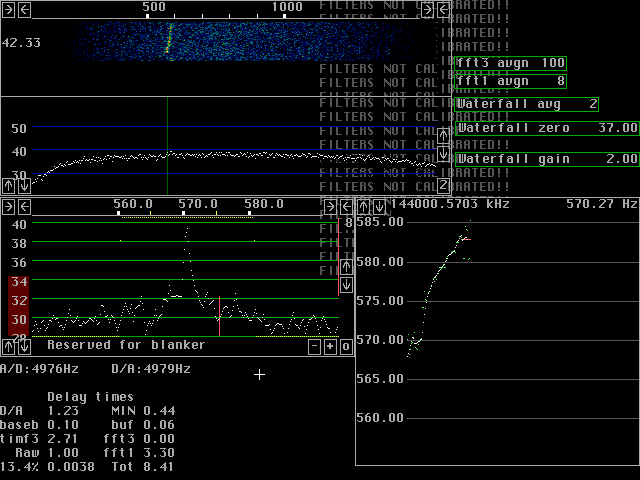|
This page is obsolete. It is left here in case someone wants
to see how things improve over time.
Here is the new page
Spectrum display and audio filter with AFC
When using a normal SSB receiver at VHF/UHF frequencies the builtin
noise blanker of the SSB radio usually works well.
Problems with strong signals within the passband used by the noise
blanker are not as much of a problem as on more crowded bands.
The noise blanker within Linrad can be used to improve in case the
analog blanker fails.
To use the Linrad blanker, the system has to be calibrated by use
of a pulse generator.
In normal operation with a good receiver having a reasonably
flat frequency response calibration is not required
As an illustration to the practical use of Linrad for a single
polarised antenna with a conventional SSB receiver fig. 1 shows
the reception of the UNKN422.WAV file played to a pentium 60MHz
computer with a SB16 (Vibra16C) soundcard.
The sampling speed is 5000Hz and the cpu usage is less than 15%.
The UNKN422.WAV file was played from another computer running
a standard Windows application.
The parameters are set for high performance in copying really
difficult signals.
The time delay is 8.5 seconds from input to audio in the
headphones, but nothing prevents the transmitter to start while
the last part of the received signal is still being processed.
The delay is caused by the narrow bandwidth used in the
waterfall display and by the long averaging time used for the AFC.
Further the 8.4 seconds delay contains an extra delay caused by
the high resolution used in the baseband graph.
For receiving there is no reason to use more than 0.5 seconds delay
in the baseband filter and less is usually adequate.
The baseband filter delays by 2.7 seconds with the settings shown here.
|





